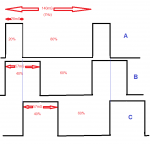Hi,
The two programs are quite "simple" so (assuming the PICaxe Program is being Downloaded correctly), then it's probably a "Hardware" issue. It might be either in the initial specification/description or the actual Hardware design or implementation. My guess would be an error in the handling of the current or voltage required by the "heater pump".
However, the program is easy to test: First put a #TERMINAL 4800 line near the top of the program (to start the PICaxe Editotor's "Terminal Emulator" window). Then, I would add a line SERTXD("I") immediately after the "PULSIN..." (or "HIGH ..") command line, and/or a line SERTXD("O") immediately after the "PULSOUT..." (or "LOW ..") command line:
That should send an "I" each time a pulse is received and/or a "O" each time a pulse is transmitted, so a string of "IOIOUO...." should continuously build up in the Terminal Window. It of course requires pulses to be input to the C.1 or Hippy's INPUT_PIN . If that works, then the SERTXD commands could be modified to report the actual pulse widths (e.g. SERTXD(" ",#PulseLen) , or after hippy's middle Do.. WHILE line) for an easy "sanity test".
Cheers, Alan.



